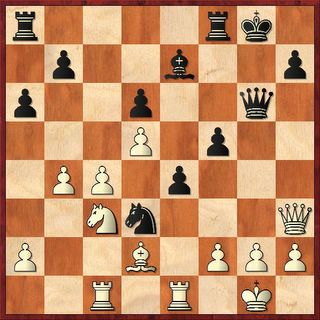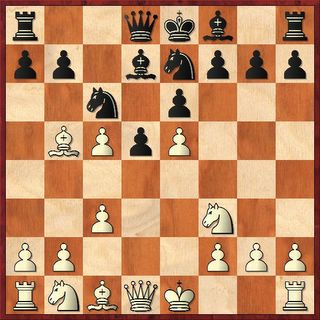Aldrich,J (1757) - Prong,C (1786)
2006 Michigan Class Championship, 1.15.2006
Two Knight's Defense: Ulvestad Variation [C57]
1.e4 e5 2.Nf3 Nc6 3.Bc4 Nf6 4.Ng5 d5 5.exd5 b5
Black's plan is to sacrifice a pawn for counterplay, development, and piece activity. Incidentally, this is the last book move. 6. Bf1 is the book move according to MCO. Fritz likes Nc3. After Bxb5 black wins 63% of the games in the Chessbase database.
6...Qxd5 Notice the difference in the positions. Despite moving first, white finds that he is behind in development and black has control of the center.
7.Qe2 I didn't consider this move, as I had never seen it played previously. The other possiblity for white is exchanging on c6.
7...Qxg2 8.Qf3
Qxe5 looked like the most playable move to me. It never occured to me that my opponent would allow me to equalize the material by trading queens.
8...Qxf3 9.Nxf3 Bd7 10.Nc3 Nd4
When I played this move I calculate the trade of bishops and knight, but I neglected to calculate that black would be able to win a pawn at the end of this variation. 11.Bxd7+ Nxd7 12.Nxd4 exd4 13.Nb5 0-0-0
I'm expecting to gain a tempo after Nxd4 and Ne5 because of the discovered attack on the knight.
14.Nxd4 Ne5 15.Nb3
This is another position where the positional differences are clear. Black has superior activity and decvelopment, but remains down a pawn. 15...Bd6
The threat is Nf3+ and then Nxh2.
16.f4
d3 is probably better here as it instantaneously gives the dark squared bishop some scope.
16...Ng6 17.d3 Nxf4 18.Bxf4 Bxf4 19.0-0 Be3+ 20.Kg2
After Kg2 I realized that black owns the only passed pawn on the board. Moreover, black needed to get his kingside pawns rolling before white managed to create a passed pawn of his own.
20...Rhf8
In preparation to push the pawn down the field.
21.Rae1
The darks squared bishop dominates the white knight while it controls the a7-g2 diagonal. However, after Bb6 white will probably play a4. Tactically the move was safe, but at the time I was afraid that my bishop would get trapped.
21...Bg5
Ironically Bg5 is probably the best move that black has available to him. I liked this move because it prevented entry to the 7th rank along the e-file (no reference to filing your taxes electronically intended here.
22.Nc5
This move temporarily freezes the f-pawn because of the potential fork on e6, where white will win an exchange.
22...h6 23.Rf3
My goal is to push the f-pawn, but the knight on c5 is preventing this. So I play my bishop to b4 (via d2) in order to drive the knight back. This will generate the time I need to start my pawns moving.
23...Bd2 24.Ref1 Bb4 25.Ne4 f6
I wanted to play f5, but white prevents this with his doubled rooks.
26.Ng3
The knight was obviously headed to f5 to attack the backward g-pawn.
26...Rd5
I wanted to eventually double my rooks on the e-file.
27.Nf5 Rf7 28.Rg3 Bf8 29.Ne3
White moves me to the e-file, just like I wanted.
29...Re5 30.Nc4 Re2+ 31.Rf2 Rxf2+ 32.Kxf2 g5
Now white has no way to prevent the f-pawn from advancing to the head of the pawn chain to take up residence on f4.
33.Rf3 Bd6
With pawns on both sides of the boards, white needs to trade off the minor pieces and head to an even rook endgame.
34.Kg2 f5 35.Ne3 f4
White has blockaded the passed pawn. Furthermore, white now sets out to prevent the rest of the pawn chain from moving forward and pushing the blockade out of the way. Note that the pin of the f-pawn means that that the attack on the white knight can be temporarily ignored.
36.h3 h5 37.Rf1 Bc5 38.Nc4 Rf5
Taking the e5 square away from the knight.
39.c3 Kd7 40.d4 Bd6
Black makes a mistake here in allowing white to trade off the minor pieces. I think Be7 was better because of the potential to play to h4 after the g4 pawn push.
41.Kf3 Rf8 42.Rg1 Rg8
Be7 was the correct way to protect the g5 pawn.
43.Nd2
White could have played 43.Nxd6 Kxd6 44. h4 g4+ 45. Kxf4 and white can hold on for a draw.
43...Ke6
The king is headed to f5 to help push the stalled black pawns.
44.Ne4 Kf5 45.Nf2
While this move was correct, it emphasizes the positional deficit that white now faces. Black now protects the g5 pawn with the king. This frees the rook to take control of the the only open file on the board.
45...Re8 46.Nd1
To prevent Re3+.
46...c5 47.d5 c4
I needed this pawn on a light square so that my bishop would have avenues to infiltrate the white position.
48.b4 Re5 49.Rg2 g4+!

The brilliance of the move is that black cannot safely recapture on g4 with the rook because after Re1 drives the white knight away from protecting the e3 square, then Re3+ will prevent the white king from protecting the rook on g4.
50.hxg4+ hxg4+ 51.Rxg4 Re1 52.Nb2 Re3+ 53.Kf2 Kxg4
The game is over after this. Black simply needs to mop up the mess and cash in the full point.
54.Nxc4 Rf3+
This intermezzo prevents white from gaining any material here. 55.Kg2 Rg3+ 56.Kf2 Bb8
57.d6 Rxc3 58.d7 Bc7 59.Ne5+
Bxe5 d8/Q and white is back in the game.
59...Kf5
After the knight leaves e5, there will be no protection for the d-pawn and black will win it momentarily.
60.Nf7 Rd3 61.a4 Rxd7 62.Nh6+ Kg5 63.Ng8 Kg6 64.b5 Kg7 65.a5 Kxg8 66.b6 axb6 67.axb6 Bxb6+ 68.Kf3 Be3 69.Ke2 Kf7 70.Kf3
White's flag had fallen, and I claimed a win on time. 0-1




























